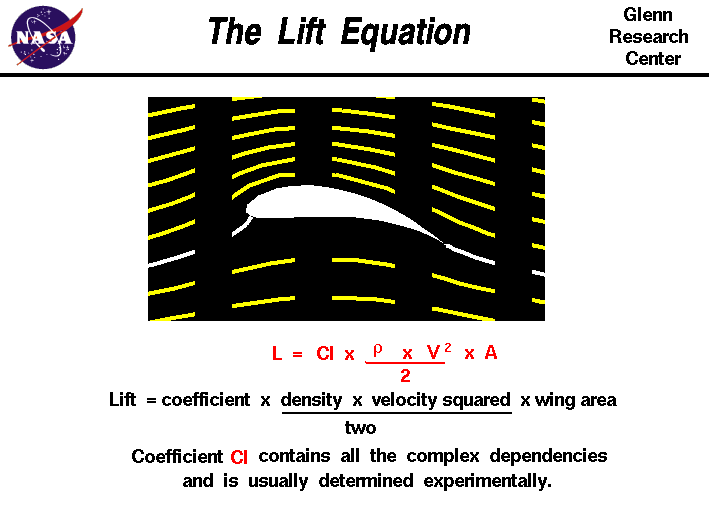
|

|
+ Text Only Site
+ Non-Flash Version
+ Contact Glenn
|
|
|

|
Investigating the Lift Equation
Activity
|

|
If so instructed by your teacher, print out a worksheet
page for these problems

Problems:
- What do we need to know in order to find the value of
L in the equation above?
- What would we have to do to the equation if we wanted to find
the value of Cl instead?
- Complete the following table and use the results to solve the
problems below.
|
Variable to
solve for:
|
Original equation
& work:
|
Final
Equation:
|
|
L
|

|

|
|
Cl
|

|
|
|
r
|

|
|
|
V
|

|
|
|
A
|

|
|
- Suppose you are flying a 17,160 pound aircraft at 48,000 ft
where the air density is 0.0004 slugs/cu. ft. Your current
cruising speed is 180 mph and the wing area of the aircraft is
2000 sq. ft. You need to make some altitude changes and will need
to know the "Lift Coefficient" of the aircraft in order to do so.
What is the Cl for your aircraft?
- Due to heavy air traffic in the area at 48,000 ft., you are
instructed to descend to 30,000 ft. where the air density is
0.00089 slugs/cu. ft. The weight and dimensions of the aircraft
have not changed, so you will need to adjust your speed for the
new cruising altitude. What should the new
V be when you level off at 30,000
ft.?
- After some time, 500 pounds of fuel have been used and the
aircraft now weighs less. Assuming you have not adjusted your
speed since you began to cruise at 30,000 ft., what is the air
density r for your current
altitude?
- After landing and unloading your cargo, your aircraft is
refueled and you take off again for the return trip. The tower
directs you to ascend to 25,000 ft. where the air density is
0.00107 slugs/cu. ft. You do so and level off. You are now flying
at 80 mph and have the aircraft on autopilot. Out of curiosity,
you decide to calculate how much your cargo weighed. Naturally,
you'll need to know how much your aircraft weighs now so that it
can be compared to the weight with all the cargo. How much does
the aircraft weigh (L) now? How much
did the cargo weigh?
- Start the
FoilSim
program.
Set the following conditions:
Airspeed = 100 mph
Altitude = 0 feet
Angle = 0 degrees
Thickness = 12.5%
Camber = 0
Area = 1.0 sq ft
Set the following values to test your aircraft and your
calculations:
Angle = 0 degrees
Thickness = 12.5%
Camber = 5.0%
- Test your calculations by entering the appropriate variable
values for each problem. Does FoilSim agree with your
calculations? If not, where do they differ? What sources of errors
can you find?
|
Related Pages:
Standards
Worksheet
Lesson Index
Aerodynamics Index
|
|
|
|
